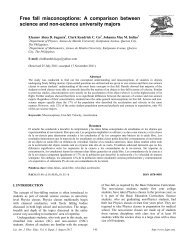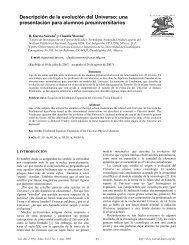Jerk, Curvature and Torsion in Motion of Charged Particle
Jerk, Curvature and Torsion in Motion of Charged Particle
Jerk, Curvature and Torsion in Motion of Charged Particle
You also want an ePaper? Increase the reach of your titles
YUMPU automatically turns print PDFs into web optimized ePapers that Google loves.
A. Tan <strong>and</strong> M. Dokhanian<br />
magnetic field B <br />
is given by the Lorentz equation. In<br />
Gaussian system <strong>of</strong> units, we have:<br />
<br />
dv <br />
m qE qv B . (3)<br />
dt<br />
II. MOTION OF CHARGED PARTICLE IN<br />
UNIFORM ELECTRIC FIELD<br />
We first <strong>in</strong>vestigate the motion <strong>of</strong> a charged particle <strong>in</strong> a<br />
uniform electric field. In this <strong>and</strong> the follow<strong>in</strong>g ezamples,<br />
we consider a positive charge (q > 0). Choose the electric<br />
<br />
field <strong>in</strong> the positive x-direction: E Exˆ<br />
. Without loss <strong>of</strong><br />
generality, choose the <strong>in</strong>itial velocity <strong>of</strong> the particle as<br />
<br />
v v xˆ<br />
v yˆ<br />
. Further, let the <strong>in</strong>itial position <strong>of</strong> the<br />
0 <br />
particle be at the orig<strong>in</strong>. The equations <strong>of</strong> motion are the<br />
follow<strong>in</strong>g:<br />
<strong>and</strong><br />
dv x <br />
dt<br />
, (4)<br />
dv y<br />
0 , (5)<br />
dt<br />
dv z 0<br />
dt<br />
. (6)<br />
where qE / m . Integrat<strong>in</strong>g Eqs. (4-6) twice with respect<br />
to time, we get:<br />
<strong>and</strong><br />
v x<br />
t<br />
, (7)<br />
C 1<br />
1 2<br />
x t<br />
C1t<br />
C2<br />
, (8)<br />
2<br />
v y C 3 , (9)<br />
y C t , (10)<br />
3 C 4<br />
v z C 5 , (11)<br />
z C t . (12)<br />
5 C 6<br />
where C 1 , C 2 , etc., are the constants <strong>of</strong> <strong>in</strong>tegration. The<br />
<strong>in</strong>itial conditions give: C1 v<br />
; C 2 0 ; C 3 v<br />
;<br />
C 4 0 ; C 5 C6<br />
0 . Thus the motion is entirely <strong>in</strong> the x -<br />
y plane with<br />
Elim<strong>in</strong>at<strong>in</strong>g t between Eqs. (13) <strong>and</strong> (14), we get<br />
v 2<br />
x y y . (15)<br />
v 2v<br />
<br />
2<br />
<br />
Thus the path <strong>of</strong> the charged particle is a parabola (Fig. 1).<br />
FIGURE 1. <strong>Charged</strong> particle <strong>in</strong> a uniform electric field.<br />
The acceleration <strong>and</strong> jerk vectors are obta<strong>in</strong>ed by<br />
successive differentiation <strong>of</strong> the velocity vector, giv<strong>in</strong>g:<br />
<strong>and</strong><br />
<br />
v <br />
v<br />
txˆ<br />
v yˆ<br />
<br />
<br />
, (16)<br />
<br />
a xˆ<br />
, (17)<br />
<br />
0 <br />
j . (18)<br />
The curvature <strong>and</strong> torsion can readily be calculated us<strong>in</strong>g<br />
Eqs. (1) <strong>and</strong> (2), giv<strong>in</strong>g:<br />
<strong>and</strong><br />
z<br />
v ┴<br />
y<br />
װv<br />
v<br />
<br />
, (19)<br />
2 2 3/ 2<br />
<br />
v<br />
t<br />
v<br />
<br />
0 . (20)<br />
Hence, an electric field can create curvature <strong>in</strong> the motion<br />
<strong>of</strong> a charged particle but not torsion. From Eq. (19), it<br />
follows that as t , 0 , i.e., the curvature<br />
dim<strong>in</strong>ishes <strong>in</strong> time. Also, if v 0 , then 0 . Thus, it is<br />
the perpendicular component <strong>of</strong> the <strong>in</strong>itial velocity which is<br />
responsible for produc<strong>in</strong>g the curvature.<br />
III. MOTION OF CHARGED PARTICLE IN<br />
UNIFORM MAGNETIC FIELD<br />
E<br />
x<br />
1 2<br />
We next <strong>in</strong>vestigate the motion <strong>of</strong> a charged particle <strong>in</strong> a<br />
x v t t<br />
, (13)<br />
2<br />
uniform magnetic field. Choose the magnetic field <strong>in</strong> the<br />
<br />
<strong>and</strong><br />
positive x-direction: B Bxˆ<br />
. Without loss <strong>of</strong> generality,<br />
y vt<br />
. (14)<br />
choose the <strong>in</strong>itial velocity <strong>of</strong> the particle as<br />
Lat. Am. J. Phys. Educ. Vol. 5, No. 4, Dec. 2011 668 http://www.lajpe.org



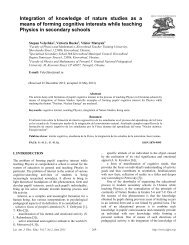
![Diversas formas de visualizar estados en un sistema cuántico [PDF]](https://img.yumpu.com/51151303/1/190x245/diversas-formas-de-visualizar-estados-en-un-sistema-cuantico-pdf.jpg?quality=85)

![Precession and nutation visualized [PDF]](https://img.yumpu.com/50786044/1/190x245/precession-and-nutation-visualized-pdf.jpg?quality=85)
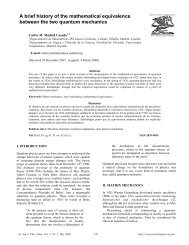
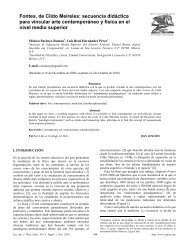
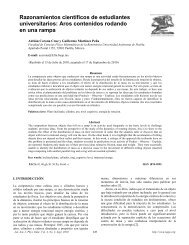

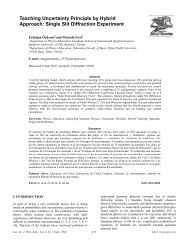
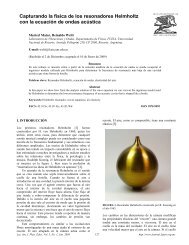
![Index [PDF] - Latin-American Journal of Physics Education](https://img.yumpu.com/47984121/1/190x245/index-pdf-latin-american-journal-of-physics-education.jpg?quality=85)
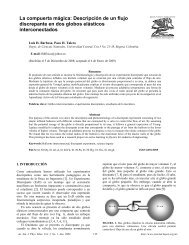
![Flujo de agua en botellas como experimento didáctico [PDF]](https://img.yumpu.com/43536300/1/190x245/flujo-de-agua-en-botellas-como-experimento-didactico-pdf.jpg?quality=85)
